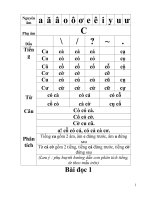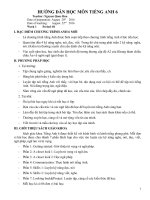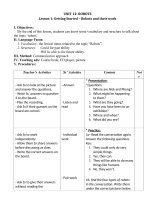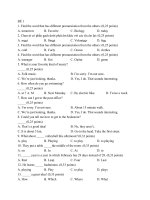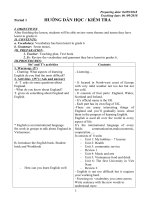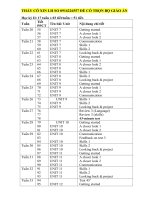- Trang chủ >>
- Sư phạm >>
- Sư phạm sinh
Tieng Anh 9 Sach moi Giao an tong hop
Bạn đang xem bản rút gọn của tài liệu. Xem và tải ngay bản đầy đủ của tài liệu tại đây (407.3 KB, 60 trang )
Writing date: 02/ 11/ 2015
Teaching date: 09/11/ 2015
Week 12
Period 34
UNIT 5: WONDERS OF VIET NAM
Lesson 1: Getting started
A. Objectives:
By the end of the lesson, ss can listen and read the conversation between Mi and
Veronica for specific information about a trip to Hue City.
1. Knowledge:
- Vocabulary: words related to wonders of Viet Nam
- Grammar: Suggest + Ving
2. Skills:
Speaking and Listening
3. Attitudes:
- Ss love the wonders of VN.
B. Preparation
- Materials: Ss’ books, text books, audio-visual aids
- Method: T- WC, group work, individual work
- Anticipated problems: Students may get difficulty in finding other ways for the
expressions in 1d P17
C. Procedures:
Teacher’s activities
Students' activities
* Warm up: Matching (3a P51) Matching (3a P51)
2. c
3. e
? Teacher shows the six pictures 1. b
4.
a
5.
f
6.
d
of places of interest in Viet Nam.
Natural wonders
Man-made wonders
? Match the words given with the
- Ha Long Bay
- Po Nagar Cham
correct pictures.correct columns
- Phong Nha Cave
Towers
? Put them in the
Cuc
Phuong
National
- One pillar Pagoda
? Can you tell where they are
situated.
? Have you ever visited a wonder of
Viet Nam?
? What is it?. Where is it?
? What is special about it?
Park
- Saigon Notre-Dame
Cathedral
I. New words
(v): giới thiệu,
- Teacher use different techniques to - recommend
teach vocabulary (situation, realia)
khuyên
- Follow the seven steps of teaching - recommendation (n) sự giới thiệu,
vocabulary
lời khuyên
* Checking vocab: jumbled words
(n): khu liên hợp,
- complex
quần thể
(n): xích lơ, xe
- rickshaw
kéo
II. Listen and read
II. Listen and read
I. New words
* Getting started
Teacher’s activities
? Open the book on the GETTING
STARTED page but with the text
covered.
? Where are Mi and Veronica?
? What may they be talking about?
- T may ask Ss to guess what the
bridge in the picture is and where it
is.
1.a. Fill in the gap with no more
than three words (1a P51)
?
Uncover the text. Play the
recording again.
? Work individually, then in pairs, to
find the words/phrases.
? Fill in the gap with no more than
three words.
- Check and write the correct
answers on the board.
1.b. Find the expressions (1b P51)
? Refer to the conversation to find
the phrases.
? Practice saying the phrases (play
the recording again as a model if
necessary).
Pay attention to
intonation when asking for, making,
or responding to recommendations
Students' activities
1.a. Fill in the gap with no more than three words (1a P51)
1. Hue City
3. go by air
5. use rickshaws
2. Three
4. Beautiful
6. The museums
1.b. Find the expressions (1b P51)
Asking for
recommendations
- And do you
know any good
places to stay in
Hue City?
- What’s the best
way to get
around?
- So what are the
things we
shouldn’t missany good
museums?
- So what else is
worth seeing?
Making
recommendations
- I suggest going
by train
- I’d recommend
The Romance
Hotel.
- It’s probably best
to use rickshaws.
- Er no, don’t
bother going to the
museums.
- You should
definitely see the
Royal Citadel.
Responding to
recommendations
- That sounds
better.
- Hmm, that’s
good to know
Yes, that’s what
I’ve heard.
2. a. Write the responses into the 2. a. Write the responses into the correct columns. (2.a P51)
Asking
for Making recommendations
Responding
to
correct columns. (2.a P51)
recommendations
recommendations
? Work independently.
Recommending Not
- Then allow them to share their
things
recoomending
things
answers before playing the recording
It’s
well
worth
- Don’t drink
What
about
Thanks,
for them to check. Play the recording
seeing.
the water.
places
outside
that’s
really
for Ss to repeat the phrases. T may
- It’s probably
- I wouldn’t
Hue City?
useful.
remind Ss to pay attention to the
to go by
eat anything
Have you got best
train.
that’s
sold
in
intonation.
any other tips?
You
really the street.
Teacher’s activities
Students' activities
must go
Agra.
2.b. Matching (2b. P51)
? Work independently to do the
matching. - Allow them to share
their
answers before giving
comments,
and
make
any
corrections.
? Work in pairs, practicing the
exchanges. T may go around to
provide help.
III. Practice
Ask and ansnswer questions about
some wonders of Viet Nam (4 P51)
- Model this activity with a more
able student.
? Work in pairs. T may go around to
provide help.
- Note that weaker Ss can stick very
closely to the model by substituting
the names of different wonders in the
conversation. However, it’s good to
encourage more able Ss to create
their
own
versions
of
the
conversation.
? Practice in front of the class.
- Remembering that this is a fluency
stage and correction should be
reserved for the end and kept to a
minimum so as not to deter Ss from
taking risks with the language.
IV. Consolidation
? Sum up the main content of the
lesson
V. Homework
? Learn by heart new words
? Do exercises B2, 3 P40
(workbook)
? Prepare: Unit 5: A closer look 1
to It isn’t really
worth seeing.
2.b. Matching (2b. P51)
1. b
2. c
3. d
4. a
III. Practice
Ask and ansnswer questions about some wonders of Viet
Nam (4 P51)
IV. Homework
- Learn by heart new words
- Do exercises B2, 3 P40 (workbook)
- Prepare: Unit 5: A closer look 1
Week 12
Period 35
Writing date: 03/ 11/ 2015
Teaching date: 10/ 11/ 2015
Unit 5:WONDERS OF VIET NAM
Lesson 2: A closer look 1
A. Objectives:
By the end of the lesson, ss will be able to:
-
Use the lexical items to describe wonders of Viet Nam
-
Identify in which situations to stress short words (a, of, or, etc.) in sentences and
say these sentences correctly
1. Language content
- Grammar:
- Vocabulary: words related to wonders of Viet Nam
2. Skills:
- Practicing skills.
3.Attitudes:
- Ss are interested in doing exercises.
4.Competences:
- Co-operation
- Self- study
- Using language to do exercises
B. Preparation:
- Teacher: Textbook, workbook, teaching plan, CD.
- Students: Textbook, workbook.
C. Procedures:
Teacher’s activities
Students’activities
I- Warm up (5'):
- Free talk
T- Ss
- Check up old lesson
II. Vocabulary (15')
1 AskSs to do the matching
independently. Then have them share
their answers with one or more partners.
T may ask for translation of the nouns in
the box to check their understanding.
With a stronger class, ask Ss to find
some real-life examples of the nouns in
the box.
- Ss work individually to complete this
exercise
Key:
1. B
2. D
3. A
4. E
5. C
6. F
- Individual work
their answers with one or more partners. Key:
1. located/situated
2. Picturesque
T may ask for translation of some
adjectives to check their understanding. 3. Astounding
5. Administrative
3 aSs work in pairs to match the nouns 4. geological
to the definitions. Allow them to share
- Ss work in pairs
their answers before checking with the
Key:
whole class. T may ask for translation of
1. b
2. d
3. a
4. e
5. c
the nouns in the box to check their
understanding. With a stronger class, ask
Ss to make some example sentences
- Ss work individuallyto complete the task
with these words.
Key:
b HaveSs complete the sentences 1. structure
2. Measures
3.
individually, using the phrases in 3a.
Setting
4. Complex
5. Recognition
then have some of them read out their
answer before checking as a class.
III. Pronunciation (15'')
Audio script:
Stress on short words in sentences
1. A: This is a (S) solution, but not the
only one.
4 Play the recording and ask Ss to listen
B: Attempts to find a (W) solution
and repeat the sentences, paying
have failed.
attention to whether the words in red in
2. A: I’m fond of (W) bananas.
each sentences are stressed or not. T may
B: Bananas are what I’m fond of (S)
play the recording as many times as
3. A: it’s not trick and (S) treat; it’s trick
or (S) treat.
necessary.
B: I need Peter and (W) Mary or (W)
- Read through and explain the rule in
John and (W) Nick to help me.
the REMEMBER!box and ask some Ss
4. A: It’s good but (W) expensive.
to give examples of the cases where the
B: You shouldn’t put ‘but’ (S) at the
short words (a, of, the, etc.) are used in
end of the sentence.
the strong form.
Example:
REMEMBER!
What are you playing at?
- Short words like articles (a, an, the), Mary is the person I’m looking for.
conjunctions (and, or), and prepositions
- When the short words are used for
(at, of, to) are usually unstressed or in
emphasis and contrast.
the weak form. However, we use these Example:
short words in the strong form in the This is the place to eat.
following cases:
It’s not a solution, but the solution.
When the short words are used at the
- When the short words are used for
end
citation.
2Ss work independently and then share
First, ask Ss to work in pairs to Example:
practice reading aloud the mini-talks and You shouldn’t put ‘and’ at the end of the
decide in which sentences the short sentence.
words are stressed. Then play the
recording. Ss listen and underline the
stressed words. T may pause after each
sentence and ask them to repeat chorally.
Correct their pronunciation if necessary.
- Do as requested
of sentences.
5
6Ss practice the mini-talks in pairs. T
may go around to provide help. Call on
some pairs to practice the mini-talks in
front of the class. Correct their
pronunciation if necessary.
IV. Consolidation (2')
- Retell the whole lesson
.V. Homework (2')
? Learn by heart all the new words.
? Do Ex in workbook
? Prepare: Unit 5: Closer Look 2
- Answer teacher's questions.
- Say out the words
- Take note
Week 12
Period 36
Unit 5:WONDERS OF VIET NAM
Writing date: 05/ 11/ 2015
Teaching date: 13/ 11/ 2015
Lesson 3: A closer look 2
A.Objectives:
By the end of the lesson, students will be able to use the impersonal passive and
the verb suggest + V-ing/clause with should
1. Language content
- Grammar:impersonal passive and the verb suggest + V-ing/clause with should
- Vocabulary:words related to wonders of VN
2. Skills:
- Practising skills.
3.Attitudes:
- Ss are interested in usingimpersonal passive and the verb suggest + V-ing/clause
with should
4. Competences:
- Co-oporation: work in pairs, groups, teams
- Self- study: work individually.
- Using language totalk about wonders of VN
B.Preparation:
- Teacher: Textbook, workbook , teaching plan
- Students : Textbooks, workbooks, notebooks.
C. Procedure:
Teacher’s activities
I.Warm up :
- Check up old lesson
Students’ activities
- Ss- T
II. Grammar
The impersonal passive
1 a First, ask Ss to study part of the
conversation
from
GETTING - Read and find
STARTED. Draw Ss’ attention to Key: It’s said that this complex of monuments is
how to form the impersonal passive one of the wonders of Viet Nam.
by analyzing the underlined part and
the rule. Then ask some more able
Ss to give some examples to
illustrate. Next, ask Ss to read the
conversation
in
GETTING
STARTED again and underline
another impersonal passive that they
can find. Ask them to share their
findings with a partner before
checking with the whole class.
b First have Ss cover up the yellow
Example:
box in 1b and try to work out the
Active
Passive
usage themselves for this structure. People think he is a
It is though that he is a
Accept all their ideas. Now uncover great teacher
great teacher
the box and allow Ss to analyse the People say she works It is said that she
rule and the examples in the box. 16 hours a day
works 16 hours a day
It was reported that
Then ask some Ss to give some more They reported that
two
people
had
been
two people had been
examples to check understanding.
We use the impersonal passive to injured in the accident injured in the accident.
express other people’s opinions. It
can be used with reporting verbs,
- Ss work independently, then pair work
including say, think, believe, know,
Key:
hope, expect, report, understand,
2. It is believed that the best time to visit the
claim, etc.
complex of Hue Monuments in April.
3. It is reported that thousands of visitors come to
enjoy breathtaking views of Ha Long Bay every
year.
4. It is claimed that Phong Nha - Ke Bang can be
compared to a huge geological museum.
5. It is understood that Binh Dai Fortress was
designed to control movement on the Perfumed
River.
6. It is expected the government will have
measures to protect and preserve our man-made
wonders.
Key:
1. It is claimed that Po Nagar Cham Towers
were built in the 8th century by the Cham
people in central Viet Nam.
3. Ss write the sentences
independently, then compare them
2. It is said that the Cham people built Po
with one or more partners. Ask some
Nagar Cham temple complex to honour
Ss to say their sentences aloud. Give
Yang Ino Po Nagar, mother of the
comments, and make any correct if
kingdom.
need.
3. It is believed that the Po Nagar Cham
Towers were built on the site of an earlier
wooden temple, which was burned by the
Javanese in A.D. 774.
2Ss
complete
the
sentences
independently. Ask them to share
their answers with a partner. Ask
some Ss to say their answers aloud.
Give comments and make any
correction if necessary.
4. It is understood that the Po Nagar Kalan is
the main tower, which is one of the tallest
Cham structures.
5. It is known that a sculpture of the
goddess Mahishasuramardini maybe
found above the entrance to the main
temple.
6. It is thought that in the 17th century, the
Viet people took over the temple tower,
calling it Thien Y Thanh Mau Tower.
Veronical: My father suggests we should go by air.
Mi:That’s too expensive! I suggest going by train.
After the verb suggest, we can use V-ing or a
Suggest + V-ing/clause with should clause with should:
S + suggest + V-ing
4 a Ask Ss to read part of the
conversation
from
GETTING
S + suggest + (that) + S + (should) +bare
STARTED, paying attention to the
infinitive
underlined part. Then explain to Ss
the structures used with the verb - Ss do as requested
suggest and ask them to make some REMEMBER!
We can also use suggest + V-ing/clause with
examples to illustrate.
b Ask Ss to study the rules in the should to report someone’s ideas about what
box. Draw Ss’ attention to the use of someone else should do, or what they should do
the verb suggest by analyzing the themselves.
examples in the box in 4b and the Example:
- Her mother suggested going to see the
REMEMBER!box. Then ask some
doctor.
able Ss to give some more examples
-
The government suggested closing a
number of primary schools.
-
5 AskSs to do the grammar exercise
individually. Remind them to refer
to the box in 4b and the
REMEMBER!box and use a
dictionary if necessary. Then have
Ss compare their answers in pairs
before checking with the whole
class.
6 a First, model this activity with a
more able student. Then ask Ss to
work in pairs. T may go around to
provide help. Call some pairs to
practice in front of the class.
b AskSs to work in pairs, recording
The professor suggested that the students
should read a number of books beforethe
exam.
Key:
2. I suggest the government should limit/limiting
the number of visitors ever day.
3. I suggest we should control/controlling the
deforestation.
4. I suggest we should put/putting these valuable
things in high-security place.
5. I suggest we should raise/raising some money.
6. I suggest we should reduce/reducing smoke
and exhaust fumes
- Do as requested
their previous partners’ ideas to the
new ones. Then T may ask some Ss
to report their previous partner’s
ideas to the whole class.
IV. Consolidation
? Retell reported speech,question
- Answer teacher's questions.
words before to -infinitive
.V. Homework
? Learn by heart all the structures
- Take note
? Do exercises in Work book
? Prepare: Unit 5: Communication
Week 13
Period 37
UNIT 4
LIFE IN THE PAST
Writing date: 08/ 11/ 2015
Teaching date: 16/ 11/ 2015
Lesson 4: Communication
A/Objectives:
- By the end of the lesson, Ss will be able to describe past practice.
1. Language content
- Vocabulary: vocabulary related to the past.
- Grammar: Used to/ didn’t use to - infinitive to talk about past practices
Express Wish for the present
2. Skills:
- Practising skills.
3.Attitudes:
Ss are interested in talking about past practices
4. Competences:
- Co-operation
- Self- study
- Using language to talk about past practices
B/Preparation:
- Materials: text books, posters, computer, projector
- Method: T- WC, group work, individual work
C/ Procedures:
Teacher’s activities
Students’ activities
I. Warm up: 3m and check the old lesson in
5m
II. New lesson: ( minutes)
1 a T can start this session by writing ‘Looking
back’ on the board and leading Ss through the
discussion of the questions. Encourage Ss to give
any or all ideas, there are no wrong answers at
this stage.
1. Extra vocabulary: (5m)
- downtown: in, towards or typical of the centre of - Listen to the teacher’s explain
a city, especially its main business area Khu vực
- Copy
thành phố
- remote (adj): far away from places where other
people live – xa xôi, hẻo lánh
- igloo (N): a small round house or shelter built
from blocks of hard snow by the Inuit people of
northern N America: lều tuyết
- domed (adj): hình vịm/ mái vịm
- arctic (Adj):related to or happening in the
regions around the North Pole: thuộc Bắc cực/
phương Bắc
2 haveSs read the definitions and look for the
words in each story. They may do this
individually or in pairs.
3 This task encourages Ss to use their critical
thinking skills to find explanations for the
questions. Ss will consequently gain a deeper
understanding of what life was like for these
people.
Have Ss work in groups. Encourage them to use
their imagination and background knowledge to
explain some information from the stories. Ss
then share their opinions with the class. T acts as
a facilitator.
- Work individually or in pairs to
complete the task.
Key:
1. illiterate 2. Pass on
3. Treat(someone)
4. Block
5. Survive 6. Dogsled
- Work in small groups.
Suggested answers:
1. It was difficult to reach the villagers
on the mountain./ There was no other
means of transport available.
2. There was no school in the villages./
The nearest school might be too far
away.
3, There were no other material
available in that deserted land./ There
was no easy means to transport
materials from other places to the
island.
4, It was impossible to build a big
house with serveral rooms in the ice
and snow./ People felt safer living in
communal group.
4 HaveSs work in group to match the respond
with the stories. Ask them to underline the key
words in the responds which help them do the
matching.
- Work in small groups.
Key:
Story 1: 2,4
Story 2 : 1,3,5
5 AskSs to work in small groups and work out a
story of their own. Make sure Ss include the
necessary information in the story suggested in
Ask Ss to work in small groups and
the task. Each group then presents the story to the work out a story of their own.
class. The rest of the class can ask questions about
the topic.
III. Homework (2minutes)
1. Review this lesson
2. Do exercises ……. (Workbook)
3. Prepare lesson Skills 2
Week 10
Period
UNIT 4
LIFE IN THE PAST
Writing date:
Teaching date:
Lesson 5: Skills 1
A/Objectives:
By the end of the lesson, ss will be able to:
- Read specific information about children’s pastimes in the past.
- making comments on or expressing opinions about facts in the past.
1. Language content
- Vocabulary: vocabulary related to the past.
- Grammar: Used to/ didn’t use to - infinitive to talk about past practices
Express Wish for the present
2. Skills:
- Reading and speaking skills.
3.Attitudes:
Ss are interested in past practices
4. Competences:
- Co-operation
- Self- study
- Creativeness: talk about past practices
- Using language to talk about past practices
B/Preparation:
- Materials: Ss’ books, text books, posters, tape and radio
- Method: T- WC, group work, individual work
C/ Procedures:
Teacher’s activities
Students’ activities
I. Warm up: 3’
II. New lesson: Skills 1
Reading (25minutes)
A. Pre-reading
Brainstorm how teens entertained themselves in
the past compared to the present. Make notes of
the activities in two lists and leave them on the
board while the class reads the conversation in
Past
how teens entertained
themselves in the past
how teens entertained
themselves now
2.
B. While-reading
- Work in groups.
Possible answer:
- blind man’s bluff
- hide and seek
- fishing
- land artillery/ Mud
banger (phao dat)
- capture the flag
- spinning tops (con
quay)
Now
Watching TV.
surfing Internet.
Internet games/
computer games
playing in mall
Friends.
See Movies.
Reading.
- Ss work individually first, then compare
the answers with their partner.
2 HaveSs read the conversation individually
and answer the questions. Check Ss’ answers as
a class. Ask Ss to show where the information
for each answer appears.
Key:
1. They used to play outdoors, in the
fresh air.
2. They met and talked face-to face.
3. It kept them healthy and in shape.
4. At home
5. You had to use your own
imagination.
6. No, they didn’t.
C. POST-READING (15minutes)
Speaking
3 AskSs to read the example in 3 and the
expressions for options and comments in the
REMEMBER!box at the bottom of the page.
Once they are clear about it in groups of three or
four. T should move around the groups and
offer guidance.
4 Apart from expressing an opinion on a
practices in the past, Ss have to decide whether
they would like to keep the practice alive and
explain why.
Allow Ss some time to read the practice, make
their decision, and think of the reasons for their
choice. They can then start their discussion. T
moves around the class to facilitate the
discussions. If something interesting is
expressed, T may wish to bring the whole class
together to discuss it.
III. Homework: (2)
1. Review this lesson
2. Do exercises ……. (Workbook)
3. Prepare lesson Skills 2
- Work in groups
- Copy the comments in the Remember box.
Ss have to decide whether they would like to
keep the practice alive and explain why.
- Discuss in groups.
- Copy and do at home!
Week 10
Period
UNIT 4: LIFE IN THE PAST
Writing date:
Teaching date:
Lesson 6: Skills 2
A/Objectives:
By the end of the lesson, ss will be able to listen for general and specific information
about school life in the past and write write a description of how children in the past
studied without technology.
1. Language content
- Vocab: vocabulary related to school life in the past
- Grammar:
2. Skills:
- Listening and writing skills.
3.Attitudes:
- nourishing and preserving the past
4. Competences:
- Co-operation
- Self- study
- Creativeness: write a description of how children in the past studied without
technology.
- Using language to write about problems in the past
B/Preparation:
- Materials: Ss’ books, text books, posters, tape and radio
- Method: T- WC, group work, individual work
C/ Procedures:
Teacher’s activities
Students’ activities
A. Warm up
Chatting:
Do you often have problems in your life?
What are they?
Who do you often ask for help?
Do you know any Helpline in Viet Nam
and in the world?
B. New lesson.
Chatting:
? Who are they in the picture?
? Where is it?
? What do you know about schools in the
past?
- ask ssto guess the statements first.
I. Listening.
1 An old man is talking about his school
days. Listen and decide if the statements
are T or F.
- guess the statements.
T then plays the recording and Ss tick the
Key:
answers. T can play the recording at least
1. F 2. T
3.T
4.NG
twice. Elicit the answers from Ss. Ask them 5.F
6. T
to explain their answers. Confirm the
answers as a class.
2. Listen again and fill in the blanks
with the correct information.
2 HaveSs read the questions, first to
determine which information they need to
Key:
fill the blanks. Ss then listen to the
1. 15
2. Bare - footed
3.
recording again and write their answers. T
Maths, history (in any order)
checks the answers as a class.
4. strict rules 5. Extra classes
Audio script:
I went to a village school. In fact, there was
only one classroom for 15 students of
different ages, both boys and girls, and one
teacher who taught everything. The school
didn’t have a name, so we just called it ‘our
school’. We used to walk to school. Some
children went bare-footed.
At school we learnt to read and to write.
We also learnt a little maths and history.
There were no science lessons, and we
didn’t have exams, either.
II. Writing
Although our school was small, it had strict
3. Make a list of the facilities you are
rules. We had to behave ourselves. We
using for your studies nowadays. Then
stood up and bowed to greet our teacher at
tick the one(s) you think was/were not
the start of every lesson. We could talk only
available about 20 years ago.
when we were allowed to. However, we
4. Choose facility which wasnot
had no homework and no extra classes. I
available twenty years ago and write a
had a lot of time to play outside and to help
short description of how students in the
my parents in the house. I love my school
past study without that facility.
and those school days.
3 Ss work in groups of three or four.
Together they make a list of the facilities
they are using for their studies. Then they
tick the ones they think were not available
about twenty years ago. T may have the
groups write their lists on board. Leave the
lists there for 4.
Sample writing:
It is most likely that students twenty years
ago were not able to enjoy the Internet in
their studies. That’s why it took them a lot
of time, energy, and even money, to do a
project that we can now easily complete in
one or two days.
For example, when being asked to write an
assignment about past habits, the students
4Ss work individually, referring to the
framework while they are writing. If time
allows, T can ask some Ss to share their
writing with the
C. Homework.
Complete the writing
Prepare Looking back and complete the
project.
Week 11
Period
UNIT 4: LIFE IN THE PAST
had to go to the library, look for books on
the topic, read the books, and hand-write
any information that they thought was
useful for their assignment. They would
also have to meet with some old people and
talk to them about the past. At home, they
had to hand-write their assignment, possibly
with a lot of erasing and rewriting of the
first draft. After finishing the draft, they had
to write a clean copy on another piece of
paper for submission.
Writing date:
Teaching date:
Lesson 7: Language focus
A/Objectives:
By the end of the lesson, ss will be able to listen revise vocab. to describe the past and
Used to to talk about the past and Wish for the present.
1. Language content
- used to
- present wish
2. Skills:
- Practising skills.
3.Attitudes:
- preserving the past.
4. Competences:
- Co-operation
- Self- study
- Using language to do exercises and preserve the past
B/Preparation:
- Materials: Ss’ books, text books, posters
- Method: T- WC, group work, individual work
C/ Procedures:
A. Warm up:
Change game: I used to
- call 5 ss to the board and play the game
S1.I used to get up late when I was
I. Looking back.
young
S2. I used to get up late and fly kites
Vocabulary
when I was young
1. Choose the best A,B,C to complete the
.............................................
sentences.
B. New lesson:
1 HaveSs complete this exercise
Key:
individually. Check their answers as a
1. B
2. A
3.C
4.A
5. B
class.
2 aSs work individually. They can
te=hen check with their partner. Confirm
the correct answers.
bHaveSs complete this exercise
individually. Check their answers as a
class.
2a. Match the verbs in A with their
definition in B.
Key:
1. b
2. e
3. a
4. c
5. d
2b. Use the verbs in A in their correct forms
to complete the sentences.
Key:
1. acting out
2. die out
3. preserve
4. collecting
5. entertains
Grammar
3. Write true sentences about the practice of
the following things in the past using 'Used
to' and 'didn't use to'
3Ss complete this task independently or
in pairs. Discussion may sometimes be
necessary to decide if a thing was/was
not practiced in the past. Only then can
they form the correct answers. Check as
a class.
Suggested answers:
1. Men used to be the bread winner of the
family.
2. Women didn’t use to travel on holiday.
3. People didn’t use to travel on holiday.
4. Families didn’t use to be nuclear.
5. People used to make banh chung at Tet
themselves.
6. Children used to play outdoor games
4. Read the situations and write wishes you
want to make for them.
Suggested answers:
1. I wish my village had access to clean
2.
3.
4.
5.
4HaveSs complete the exercise
independent. Have them share their
wishes with the class.
5EncourageSs to use their imagination
and work out wishes for the situation.
Have them share their answers with the
class.
piped water.
I wish there was/were a bridge over the
river, so we did not have to cross the river
by boat twice a day to school.
I wish there was/were an organization for
social activities for teenagers in my town.
I wish I was/were tall enough to play
basketball.
I wish there were four seasons in my area./
I wish we had spring and autumn in my
area.
5. Look at the picture and finish the boy's
wishes.
Suggested answers:
1. I wish it would stop raining.
2. I wish the wind weren’t blowing so hard.
3. I wish the sun were shining.
4. I wish I were sitting in a warm house.
Communication
6 Ss work in pairs or small groups to
complete the exercise. Check as a class.
Then they can practice the conversation
with their best pronunciation and
fluency.
This project aims to encourage Ss to do
more research about the past with a
focus on traditions and habits which are
dying out.
Divide Ss into groups of four to five and
instruct them on what they have to do.
Have Ss present their posters in the next
lesson. When all the groups have given
their presentations, the whole class can
vote for the best.
C. Homework.
- Complete the Looking back
- Prepare Unit 5 Getting start.
6. Rearrange the sentences to make a
meaningful conversation.
Key:
Order: 1-4-5-2-9-7-8-6-3
PROJECT
Preserving the past
Encourage them to interview previous
generations - either members of their family or
neighbours. Tell them to:
- Choose the pastime they most appreciate
and would most like to preserve
- Explain their choice
- Work on a plan of how they can help to
preserve it
Week 15
Period 43
Preparing date: 26/ 11/ 2015
Teaching date: / / 2015
9A1: .....................................
UNIT 6: VIET NAM THEN AND NOW
Lesson 1: Getting started
A. Objective.
By the end of the lesson, Ss can:
- listen and read the conversation of Duong, Phuc, Tom and Nhi about their school in
the past for details
- talk about the changes of their own school
B. Content.
- Vocabulary: things related to life in the past
- Grammar: simple past
C. Preparation
- Teaching aids: Textbook
- Work arrangement: T-WC, group work, pair work
- Anticipated problems: There may not be enough time to do all the tasks, teacher
can have students do task 2 P61 at home.
D. Procedure
Teacher and Students' activities
Content
Warmer: Complete the table
Complete the table
? How do we form an adverd?
- Normaly, we add "ly" at the end of an
adjective.
? Write the correct adverbs in the second
Adjectives
Adverbs
column
- dramatic
- dramatically
- considerable
- considerably
- significant
- significantly
- slight
- slightly
- gradual
- gradually
I. New words
I. New words
- Teacher use different techniques to teach - thatched house (n): nhà tranh mái lá
vocabulary (situation, realia)
(n): hào giao thông
- trench
- Follow the seven steps of teaching - tiled roof
(n): mái ngói
vocabulary
II. Listen and read
II. Listen and read
* Set the scene:
‘Past and Present’ = Then and Now
- Write the words ‘Past and Present’ on
the board.
? Give another expression for the phrase.
?Look at the picture and the heading Our - We can see Duong, Phuc, Tom and Nhi.
school in the past.
- I think they are at a photo exhibition.
